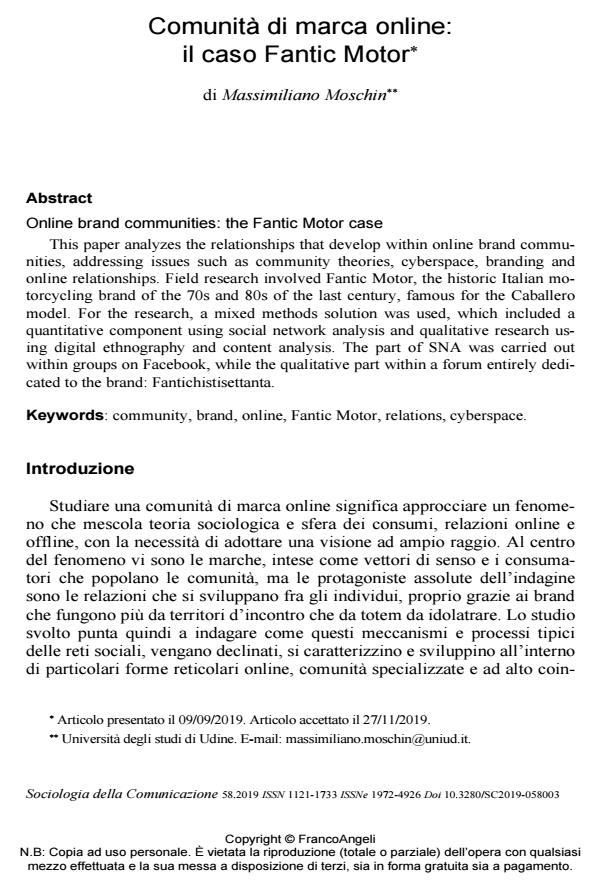Comunità di marca online: il caso Fantic Motor
Titolo Rivista SOCIOLOGIA DELLA COMUNICAZIONE
Autori/Curatori Massimiliano Moschin
Anno di pubblicazione 2020 Fascicolo 2019/58 Lingua Italiano
Numero pagine 19 P. 44-62 Dimensione file 481 KB
DOI 10.3280/SC2019-058003
Il DOI è il codice a barre della proprietà intellettuale: per saperne di più
clicca qui
Qui sotto puoi vedere in anteprima la prima pagina di questo articolo.
Se questo articolo ti interessa, lo puoi acquistare (e scaricare in formato pdf) seguendo le facili indicazioni per acquistare il download credit. Acquista Download Credits per scaricare questo Articolo in formato PDF

FrancoAngeli è membro della Publishers International Linking Association, Inc (PILA)associazione indipendente e non profit per facilitare (attraverso i servizi tecnologici implementati da CrossRef.org) l’accesso degli studiosi ai contenuti digitali nelle pubblicazioni professionali e scientifiche
;
Keywords:Community, brand, online, Fantic Motor, relations, cyberspace
- Boellstorff T. (2016), For Whom the Ontology Turns Theorizing the Digital Real, «Current Anthropology«» Volume 57, Number 4.
- Adjei M., Noble S., Noble C., (2010), The influence of C2C communications in online brand communities on customer purchase behaviour, «Journal of the Academy of Marketing Science», 38.
- Algesheimer R., Utpal M. D., Herrmann A., (2005), The social influence of brand community: evidence from European car clubs, «Journal of Marketing», Vol. 69.
- Baym N.K. (2010), Personal Connections in the Digital Age, Polity Press, Cambridge.
- Bertolazzi A., Strizzolo N., (2012), Requiem for the virtual communities. Long life to the Social Networks, Prato CIRN Community Informatics Conference.
- Blanchard A., Horan T., (1998), Virtual Communities and Social Capital, «Social Science Computer Review«, Vol. 16, N. 3.
- Boccia Artieri G. (2012), Stati di connessione – Pubblici, cittadini e consumatori nella (Social) Network Society, Franco Angeli, Milano.
- Brogi S., (2014), Online Brand Communities: A Literature Review, 2nd World Conference on Business, Economics and Management, «Procedia. Social and Behavioural Sciences», Volume 109, 8 January 2014.
- Burnett G., (2000), Information exchange in virtual communities - A typology, «Information Research. An International Electronic Journal», Volume 5, N. 4.
- Castells M. (1996), The net and the self: working notes for a critical theory of the informational society, «Critique of Anthropology», 16(1).
- Castells M. (2000), Toward a Sociology of the Network Society, «Contemporary Sociology», Vol. 29.
- Cohen A.P. (1985), The Symbolic Construction of Community, Routledge, London.
- Cova B. (1997), Community and consumption: Towards a definition of the “linking value” of product or services, «European Journal of Marketing», Vol. 31.
- Cova B., Pace S., (2006), Brand community of convenience products: new forms of customer empowerment – the case “my Nutella The Community”, «European Journal of Marketing», Vol. 40.
- Fernback J., (2007), Beyond the diluted community concept: a symbolic interactionist perspective on online social relations, «New Media + Society», 9, 49.
- Fournier S., Lee L., (2009), Getting Brand Communities Right, «Harvard Business Review».
- Godwin M., (1994), Nine Principles for Making Virtual Communities Work, «Wired», 2.06.
- Hampton K.N., (2004), Networked sociability online, off-line in Castells M., The Network Society - a Cross Cultural Perspective, Edward Elgar Publishing, Cheltenham Glos.
- Hunter A. (1974), Symbolic Communities: The Persistence and Change of Chicago's Local Communities, University of Chicago Press, Chicago.
- Hunter A. (2008), Contemporary Conceptions of Community, in Cnaan A.R., Milofsky C., Handbook of Community Movements and Local Organizations, Springer, New York.
- Jenkins H. (2006), Fans, bloggers, and gamers: Exploring participatory culture, New York University Press, New York.
- Kim A.J., (2000), Community Building on the Web: Secret Strategies for Successful Online Communities, Peachpit Press, San Francisco.
- Kollock P., (1999), The economies of online cooperation: gifts and public goods in cyberspace in Smith M.A., Kollock P., Communities in Cyberspace, Routledge, London.
- Kozinets R.V., (1999), E-Tribalized Marketing? The Strategic Implications of Virtual Communities of Consumption, «European Management Journal», Vol. 17, N. 3.
- Kozinets R.V., (2002), The Field Behind the Screen: Using Netnography for Marketing Research in Online Communities, «Journal of Marketing Research», 39.
- Kozinets R.V., De Valck K., Wojnicki A.C., Wilner S.J.S., (2010), Networked Narratives: Understanding Word-of-Mouth, Marketing in Online Communities, «Journal of marketing», 74(2).
- Levy P. (1994), L’intelligence collectif (Collective Intelligence), La Découverte, Paris.
- Mcwilliam G., (2000), Building stronger brands through online communities, Sloan Management, Cambridge.
- Mesch G.S., (2008), Online Communities in Cnaan R.A., Milofsky C., Handbook of Community Movements and Local Organizations, Springer, New York.
- Muñiz.A, O’guinn T. (2001), Brand Community, «Journal of Consumer Research», vol. 27.
- Rheingold H. (2000), The Virtual Community: Homesteading on the Electronic Frontier - Revised Edition, The MIT Press, Cambridge.
- Schau H.J., Muñiz A.M. (2002), Brand Communities and Personal Identities: Negotiations in Cyberspace, «Advances in Consumer Research», Volume 29.
- Schau H.J., Muñiz A.M., Arnould E.J. (2009), How Brand Community Practices Create Value, «Journal of Marketing», Vol. 73.
- Scott J. (2000), Social Network Analysis a handbook, Sage Publications, London.
- Suler J.R. (2000), The Psychology of Cyberspace, Ryder University.
- Turkle S., (1984), The Second Self: Computers and the Human Spirit, Simon & Schuster, New York.
- Turkle S., (1995), Life on the Screen: Identity in the Age of the Internet, Weidenfeld & Nicolson, London.
- Turner J.W., Grube J.A., Meyers J., (2001), Developing an optimal match within online communities: An exploration of CMC support communities and traditional support, «Journal of Communication», 51(2).
- Van Dijk J.A.G.M. (1997), The Reality of Virtual Community, «Trends in Communication», Vol.1, n. 1.
- Wellman B. (1999), Networks in the Global Village: Life in Contemporary Communites, Westview Press, New York.
- Wellman B., Gulia M., (1999), Virtual Communities as Communities: Net Surfers Don’t Ride Alone in Smith M.A., Kollock P., Communities in Cyberspace, Routledge, London.
Massimiliano Moschin, Comunità di marca online: il caso Fantic Motor in "SOCIOLOGIA DELLA COMUNICAZIONE " 58/2019, pp 44-62, DOI: 10.3280/SC2019-058003